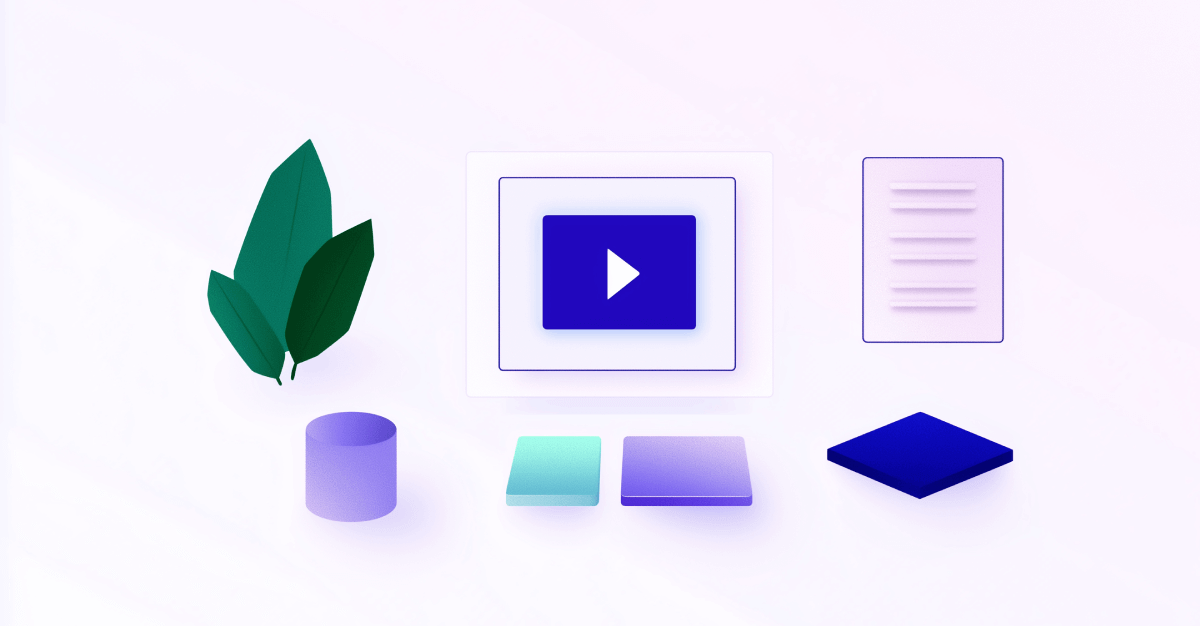
Put your hand up if you've ever wanted to read a “For Dummies” or “Idiot’s Guide” book to learn something.
But you were too embarrassed to pick it up. I've been there!
Years ago, I read a stack of “For Dummies” books when I first became interested in computers and technology.
With comics, down-to-earth language and examples, these books are a great way to learn about a topic as a beginner.
But today? I'm not sure I'd want to carry around a book with a “For Dummies” title, especially if it related to my career or business.
Fortunately, we've got you covered.
In this SEO for Dummies guide, you'll learn 13 tips that'll ground you in the basics and give you access to all the SEO fundamentals.
Bookmark this page so you can refresh your memory whenever you have the need.
Lesson 1: What Is SEO?
SEO stands for search engine optimization. It's the art and science of matching your information—your webpages, products and services—with what people are searching for online.
For example, if you enter a search like “best electric car reviews” into Google, who comes up at the top of organic search results?
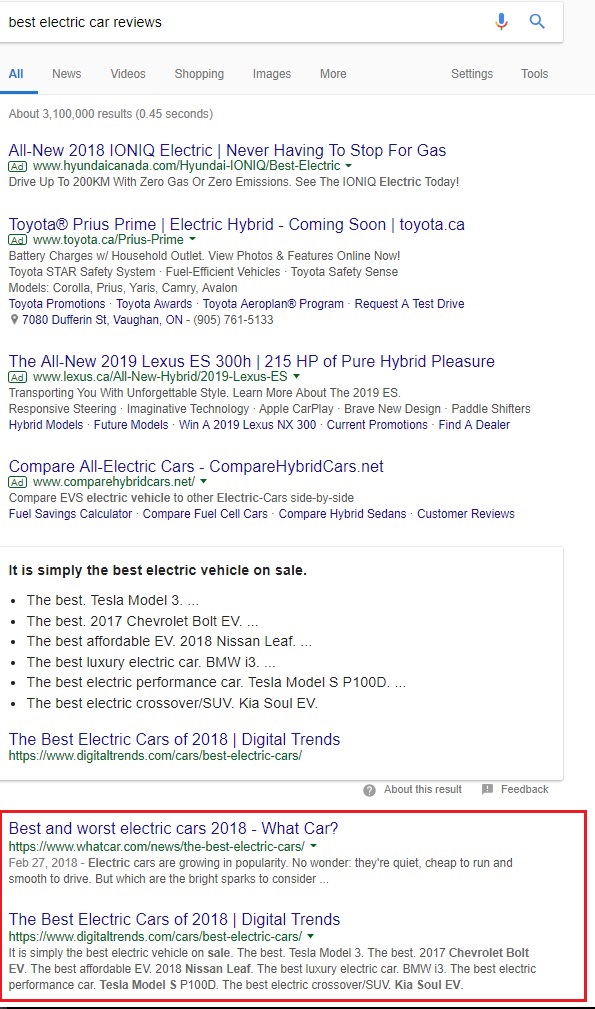
How did whatcar.com and digitaltrends.com end up at the top of the search results?
They've created relevant, up-to-date content that addresses the search query.
SEO is all about answering the questions and information needs of your customers rather than interrupting them with a paid advertisement. With SEO, you can create a webpage and have it generate leads and sales for months and years after you publish it.
In contrast, other marketing methods like PPC (pay per click advertising such as Google AdWords and Facebook Ads) only deliver results as long as you keep paying.
SEO is not some arcane technical area. It has a proven track record of delivering business results. Let’s explore that next.
Lesson 2: How Does SEO Help My Business?
Let’s get down to brass tacks. What kind of results in the form of sales and leads will SEO deliver to your business?
Consider this following SEO success story in the wedding industry.
Bride Appeal is a marketing firm that specializes in using SEO and internet marketing to help wedding companies get more business. What does that result look like for the bottom line?
- “Wedding inquiries are up 254% over the last year.” (Owner of an event venue)
- “[A client] had booked up their entire wedding season (Spring, Summer and Fall) by the end of Spring, and 80% of their new clients came exclusively from search.”
Of course, SEO helps many other types of businesses besides the wedding industry as well.
According to Rocket Digital, a digital marketing agency in Canada, SEO also delivers results in the automotive industry.
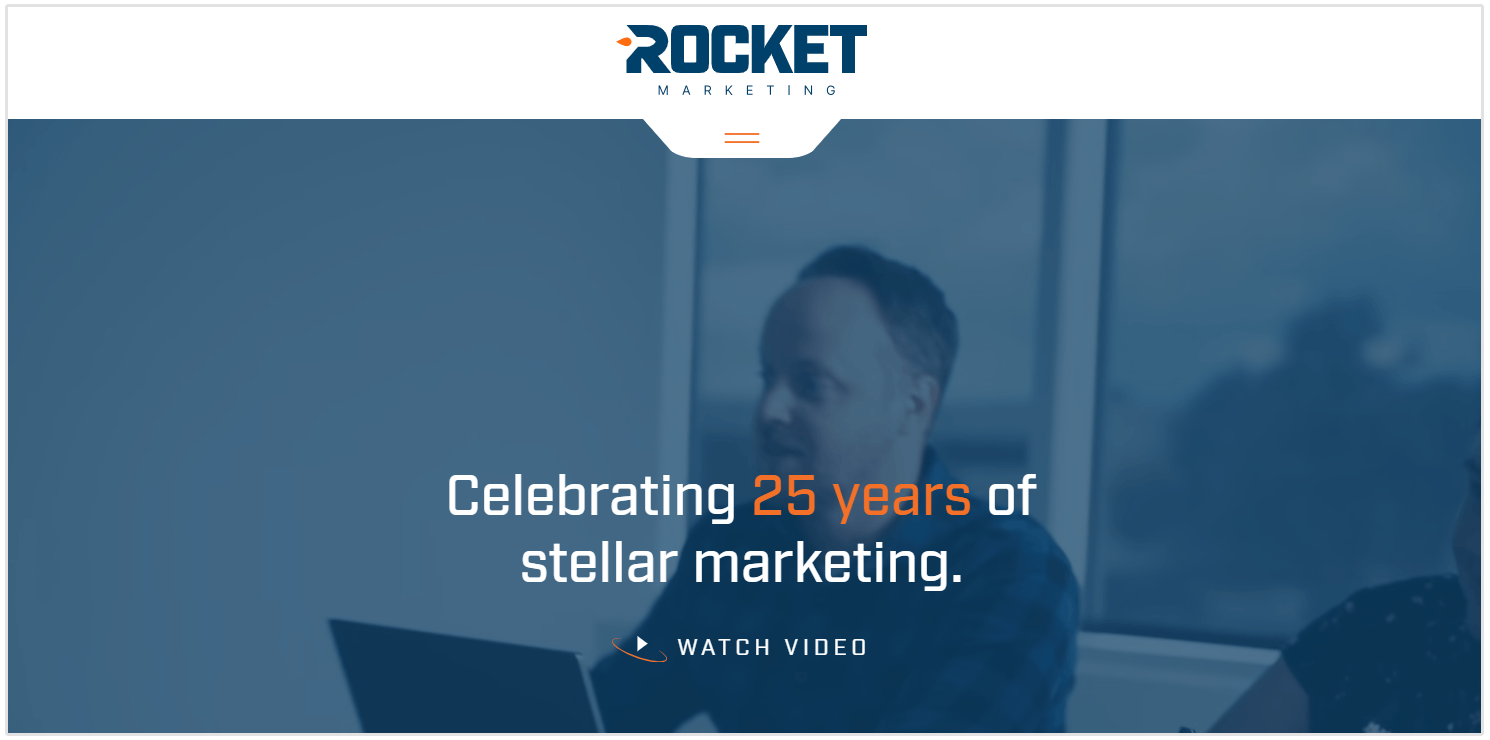
One of their clients increased traffic to their website by more than 50% by using SEO, even though they're in the highly competitive used car industry.
If wedding planners and car sellers can win with SEO, you can too!
Now that you know that SEO generates real results in business, I'm going to channel my love for history to give you the key highlights you need to know about how we got to where we are today in SEO.
Lesson 3: A Very Short History of SEO
If you take the long view on SEO, there are three broad eras you need to know. It'll come as no surprise that all three of these eras are defined by Google, the world’s most popular search engine.
Era 1: The Pre-Google Era
In the late 1990s and early 2000s, SEO was simple for companies to manipulate. Just put your keywords all over your website again and again, and you'll probably get traffic.
For end users, this era delivered search results of uneven quality. Fortunately, a new search engine would arrive and change everything.
Era 2: Google Era 1 (late 1990s - late 2000s)
As Google grew from a small project at Stanford, it quickly became the world’s most popular search engine. Google’s emphasis on citations—how many websites link to your website?—was a critical improvement.
While Google’s search engine model has never been disclosed in detail, SEO experts have found ways to optimize the system.
Two SEO methods stand out from this era. Some marketers published “spun articles” (i.e. computer-generated remixes of content) to gain Google’s favor. Next, we also saw the rise of content mills—companies that paid large numbers of writers small fees to churn out content. For a time, such methods worked.
Era 3: Quality Strikes Back (2011 - present)
Several major Google search engine changes starting in 2011 changed the SEO industry forever. In particular, Google updates started to target (and punish) spam and low-quality websites.
Here are some of the most important changes:
- The Panda Update (February 2011). This update caused content mills and many other low-quality websites to disappear from the top ranking spots. Some businesses lost significant revenue as their traffic fell. Indirectly, this update rewarded higher-quality websites with a better user experience.

- The Penguin Update (April 2012). The Penguin update continued the emphasis on quality. Further, this update began to penalize whole websites for spam techniques like keyword stuffing, rather than penalizing just the individual webpages. Google's 2012 blog post announcing the change is also notable for distinguishing between “white hat” (e.g. high-quality SEO techniques) and “black hat” (i.e. low-quality SEO techniques reliant on spam).
- The Fred Update (March 2017). This update focused on the tension between user experience and marketing. In brief, highly aggressive monetization methods—such as full-screen advertisements that obscure the underlying content—result in reduced traffic. In addition to excessive advertising, some SEO experts believe that low-quality links were also targeted in this update, such as a high volume of links that appear highly similar.
What does this mean for you as an SEO beginner?
First, exercise caution in using SEO methods and techniques that originated before these updates, because they may violate Google’s expectations.
Second, focus on the recurring themes in Google’s updates—publishing high-quality information and emphasizing the user experience.
Now that you know what SEO is and Google’s philosophy on quality, let’s get down to work on how to do SEO.
Lesson 4: The Fundamentals of On-Page SEO (Can Google Read Your Website?)
Here’s the honest truth: It's possible to be too clever in creating your website.
In this guide, let’s focus on a handful of simple techniques to improve your on-page SEO.
- Identify a few relevant keywords. Research a few keywords that describe the essential products and services of your website. For example, if you're a tax attorney, your keyword shortlist might include things like "tax expert," "IRS legal help" and "tax attorney."
- Use those keywords strategically. Use your chosen keywords a few times on each page. Your keywords should read naturally—simply repeating your keyword phrase dozens of times on a page won't help.
- Optimize your images. The way you publish images to your website can support your SEO goals. Specifically, look for ways to use your keyword in relevant image file names and alt tags. For example, you might use the phrase “JaneSmith_TaxAttorney” as your image filename and alt tag, instead of just “image.jpg.”
- Add internal links. If a prospect lands on your services page, they might be curious about your professional background as well. In that case, it'd make sense to link to your about page so they can easily find that information. If your website has a blog or articles, look for opportunities to link to other articles that cover related themes.
Want to carry out an in-depth check of your on-page SEO? Check out “The Definitive Onsite SEO Checklist for Publishing Optimized Content.” Following a checklist is a great way to make sure you never miss anything important!
Lesson 5: The Fundamentals of Backlinks
Backlinks are like “word of mouth” for the web—the more people who talk about you, the more likely you are to be discovered.
However, there’s a twist!
Not all backlinks are created equal. A backlink from a high Domain Authority website like CNN or the New York Times is more powerful than a backlink from a website created last week.

Why? There are two reasons.
First, a backlink from a highly trusted website signals some level of approval and validation, so website visitors are more inclined to view your website in a positive light. Second, highly trusted websites are considered to have more SEO weight as measured by Domain Authority.
Lesson 6: The Fundamentals of User Experience
Making your website understandable to Google is only part of the story. It also has to be meaningful for real human users.
While Google hasn't defined good user experience in detail, we can make an educated guess based on the practices they discourage.
- Don't plagiarize. Copying content from other sources and putting it on your website is a bad idea. It makes it look like you have no ideas of your own, plus Google’s Webmaster Guidelines are strongly against it.
- Avoid keyword stuffing. Many years ago, some SEOs attempted to manipulate search engines by repeating keyword phrases over and over again, but in a hidden way. They'd sometimes repeat the keyword in white text on a white background, so that search engines would see it but not people. Those practices don't work and may trigger the displeasure of Google.
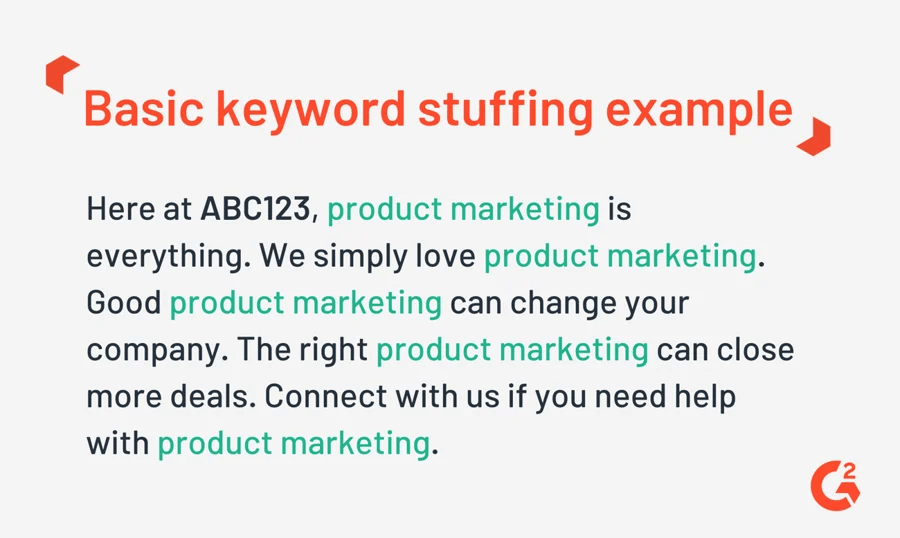
- Avoid excessively aggressive monetization and advertising. Yes, this requires some judgment and interpretation to understand. Think about product placements in movies as an analogy. You might not mind if a character drives a BMW for a few scenes. However, if the character keeps bringing up the brand at random moments? That wouldn't make for a good user experience. If somebody lands on your website to read an article, access a guide or get some other information, make sure they can get that information easily rather than being sidetracked by an ad.
- Add easy-to-find navigational elements. Have you noticed that nearly all websites have navigation links at the top, bottom and elsewhere? For example, you'll generally see links to a homepage, about page, privacy policy, contact information and beyond. Including that information makes your website easier to use and increases trust because users can reach you if they desire.
- Guide the user to the next step. It's easy to get carried away with all the options when you're creating a website. I recommend asking this question for your homepage and other important webpages: “What's the single most valuable action I want users to take when they visit this page?” The most common answers tend to be: Fill in a contact form, join your email list or buy your product. Then, make sure it's clear and easy for users to take that action on the page.
- Test different browsers. Most of the time, I use Google Chrome or Firefox. However, many people use other web browsers such as Safari, Internet Explorer and Opera. To provide a good user experience, check what your website looks like on different browsers. If something looks strange or unreadable, ask your developer to take a closer look at the problem. As an alternative, some websites display a note stating “our website works best on Google Chrome” or the equivalent for their preferred browser.
Lesson 7: Publishing Valuable Content
With the right approach, publishing original content on your website today will bring results for years into the future.
When his pool company was struggling, Marcus Sheridan started to publish original content on his website like “Fiberglass Pool Prices: How Much Is My Pool Going to Cost?”

In a New York Times interview, Sheridan said, “I have been able to track a minimum of $1.7 million in sales to that one article.”
The point of Sheridan’s example? One of the best ways to publish valuable content on your website lies in answering customer questions.
Come up with a list of the 10 most common questions customers ask when you meet with them. Then, create content—articles, videos, presentations and other online assets—to answer those questions.
Tip: If you're not a writer, you can start by creating other types of content like YouTube videos and then engaging a writer to create blog posts based on them.
Lesson 8: Learn from Your Competitors
You don't need to come up with SEO and link building ideas from scratch. You can get SEO inspiration easily from your competitors.
Let's say you were working on cospot.com. You can use SEOptimer to track the backlinks that competing websites have, and find out how they're acquiring those backlinks.
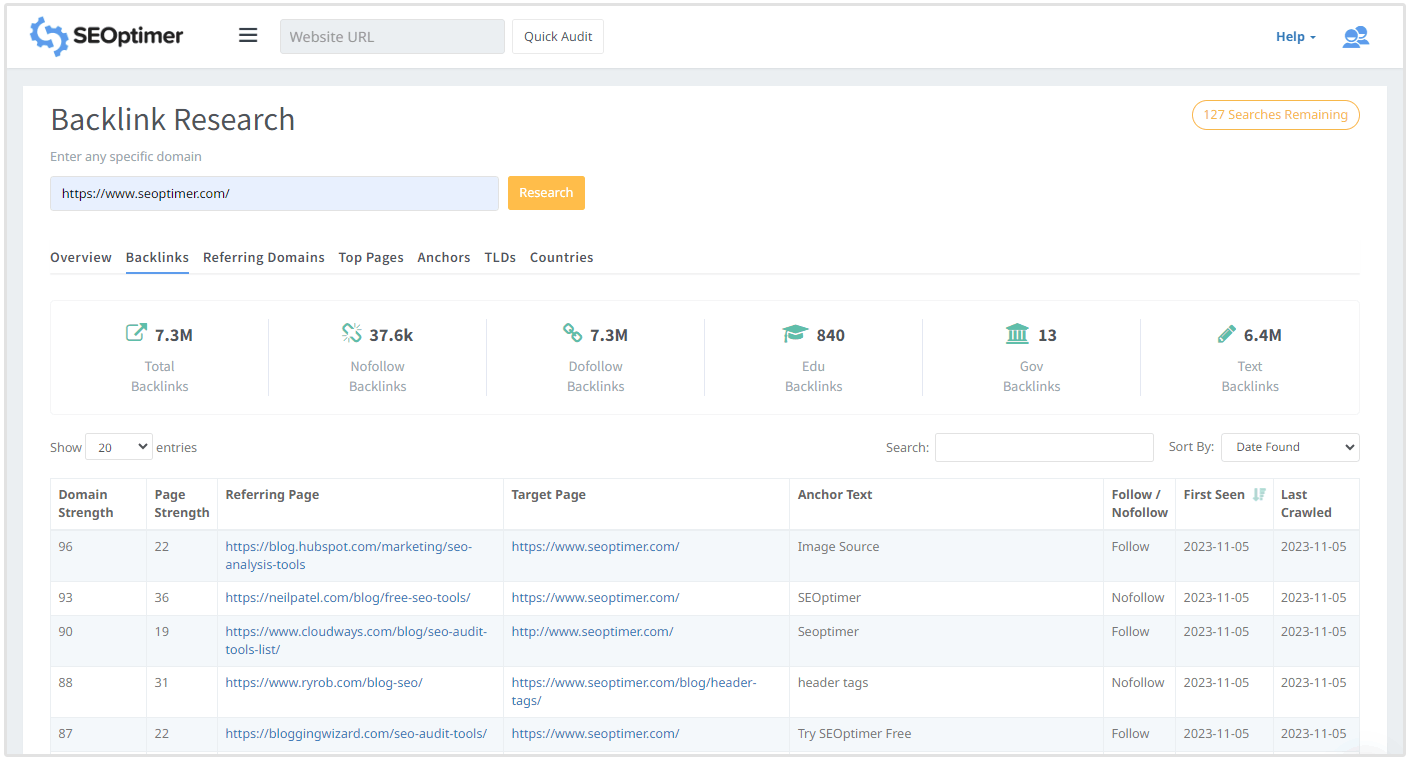
Studying the competition’s backlinks accelerates your SEO results because you can reach out to websites that have a track record of linking to other websites in your industry.
Lesson 9: Measure What Matters, 3 Metrics to Track
As an SEO beginner, keep your SEO measurements simple. I recommend focusing on backlinks over time, unique visitors and time spent on the website.
- How many backlinks do you have? Specifically, track the number of backlinks month over month. If that number isn't going up, your SEO needs work. Try to create more useful content and get the word out about it.
- How many unique visitors do you get per month? Using Google Analytics, you can see how many visitors come to your website. If your SEO efforts are succeeding, the number of unique visitors will increase.

- How long do visitors spend on your website? If most of your website visitors leave your site a few seconds after arriving, that's not a good sign. As a rule of thumb, I like to see average time on site of 30 seconds or a few minutes. That suggests that visitors are interested in what they see. You can find this information also in Google Analytics.

Advanced Users Only: The more measurement data you take on, the more complex your marketing will become. If you have a good grasp of SEO and want to track more metrics, read “Measure SEO Performance Like a Boss: 9 SEO Metrics You Need to Track.”
But if you have a new SEO program, keep it simple for now with these three metrics I covered above.
Lesson 10: Essential SEO Tools
Signing up for too many SEO tools will only confuse you. Take the SEO for dummies approach by focusing on a small number of tools.
Here are the three essential tools that I recommend for a beginner:
- Google Analytics. This free software tracks how many people visit your website, what pages are most popular and more.
- Google PageSpeed Insights. Slow websites provide a poor user experience and may hurt your SEO performance. Use this tool to find ways to improve.
Here's one bonus recommendation: Set up an email service like MailChimp. Why? It gives you a way to capture email addresses and stay in touch with people who visit your website.
Lesson 11: Observe How You Use the Web for a Day
When you are deeply focused on your website, you can forget what it's like to be a regular web user. Use this section to remind yourself.
Just follow these steps:
1. Start with a question. For example, what's a broken or worn out product you need to replace at your home? Say you need new headphones for your computer.
2. Search for that information on Google. You might use a query like “headphones reviews.”
3. Examine the top 3-5 results. Here's where you shift focus to examine what's working. How are these sites providing a good user experience? Based on what you see, would you be motivated to engage further with the websites you visit (e.g. read other pages, buy products, sign up for their email list)? Why or why not?
4. Take a lesson away for your business. Based on what you learned above, look for ways to improve your content and user experience. Remember, sometimes you'll learn “anti-lessons,” noticing a practice you want to avoid. That's sometimes just as valuable.
Lesson 12: Where to Go Next for SEO Education
In the SEO industry, we're blessed to have many experts who are ready and willing to share their insights with us. There are also quite a few charlatans, so you have to be thoughtful about whom you follow.
Here are three more resources I recommend:
- Search Engine Journal. Want to see how SEO fits in with other digital marketing methods like PPC (pay per click)? This is a good resource to explore. It's aimed at digital marketing professionals.
- Google Webmaster Central Blog. Discover what Google values and how it approaches online search. Note that this resource focuses on Google and tends to be somewhat technical.
- Search Engine Land. An excellent industry news source to learn about new opportunities and technologies. You'll find dedicated coverage of local search, Google, Bing and news on SEO events.
The final lesson in this SEO for dummies guide is something a bit different. You'll have to step away from the keyboard for this one.
Lesson 13: Talk to Your Website Users
Yes, getting on the phone with your website users and customers will help you improve SEO.
Specifically, you'll find out if your website is confusing or doesn’t work technically. There are a few ways to put this tip into action:
- Send a survey to your users. You can set up a short survey on SurveyMonkey and then send an email to your users to ask about their experience. Ask questions about what parts of your website are easy to use, what areas are confusing and what they wish your website had or didn't have.
- Get on the phone. Send an email to one of your customers and ask to get on the phone with them. In this call, focus on two or three focused themes about your website. For example, how did they find out about you? What's their favorite page, article or video? What do they wish you'd change?
These conversations will give you additional ideas and examples on how to improve your website. After all, you can't remember everything from the numbers alone.
Wrapping Up
We've covered much ground in this SEO for dummies guide.
You learned what SEO is and the history of search engine updates. You also learned about backlinks, user experience and how to measure your results.
That's more than enough to get you started and help you ask better questions to your SEO experts on their approach.
Bruce Harpham offers growth marketing services for software companies. He is also the author of “Project Managers At Work.” His work has appeared on CIO.com, InfoWorld and Profit Guide. Read his B2B SaaS marketing case studies covering Close.io, Click Funnels, and Woodpecker on his website.




